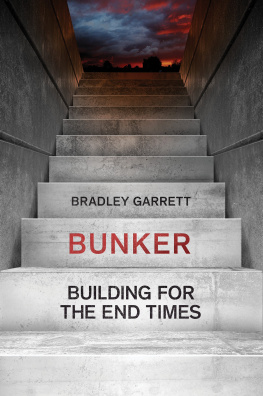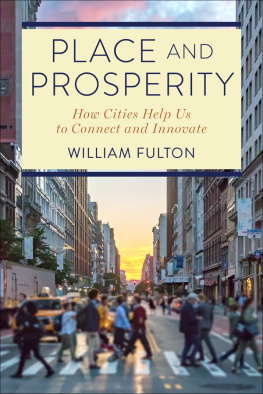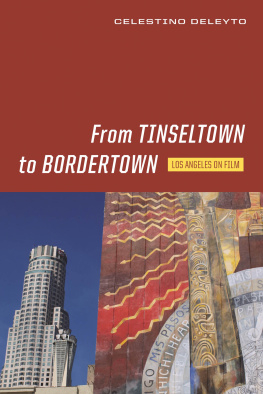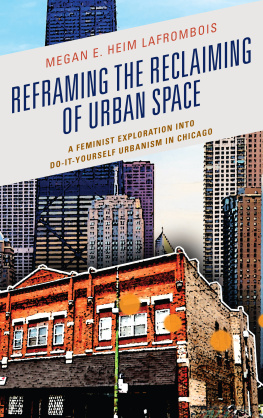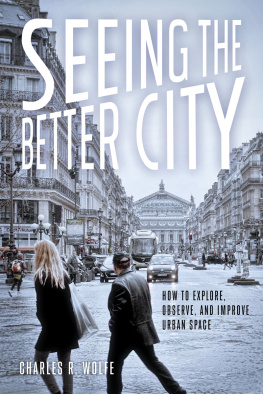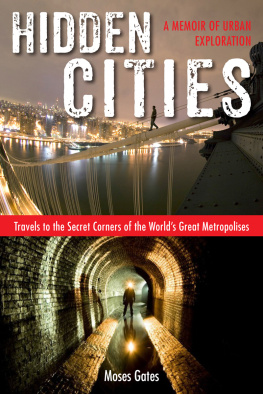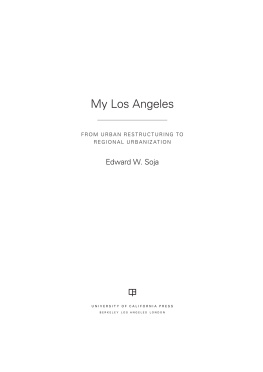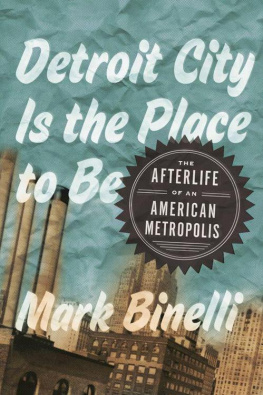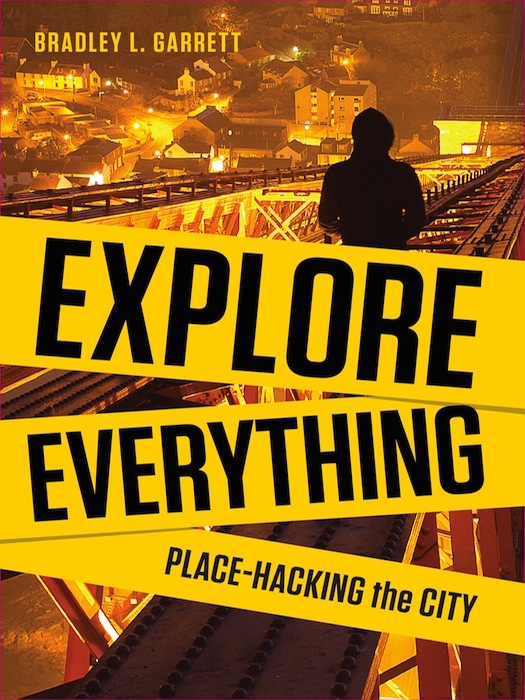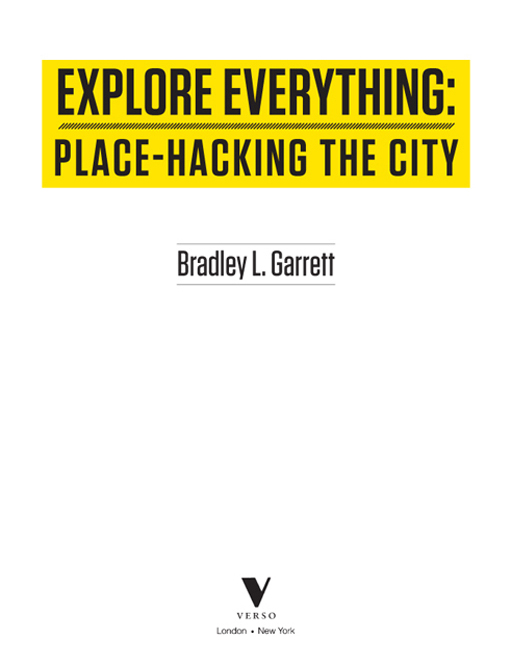First published by Verso 2013
Bradley L. Garrett 2013
Individual image credits Marc Explo () 2013
All other photos Bradley Garrett 2013
All rights reserved
The moral rights of the author have been asserted
1 3 5 7 9 10 8 6 4 2
Verso
UK: 6 Meard Street, London W1F 0EG
US: 20 Jay Street, Suite 1010, Brooklyn, NY 11201
www.versobooks.com
Verso is the imprint of New Left Books
Hardcover ISBN: 978-1-78168-129-9
eBook ISBN: 978-1-78168-187-9
British Library Cataloguing in Publication Data
A catalogue record for this book is available from the British Library
Library of Congress Cataloging-in-Publication Data
Garrett, Bradley L.
Explore everything : place-hacking the city / Bradley L. Garrett.
pages cm
Includes bibliographical references and index.
ISBN 978-1-78168-129-9 (hardback)
1. Garrett, Bradley L.Travel. 2. Urban geography. I.
Title.
G246.G37.A3 2013
910.4dc23
2013020578
v3.1
For Marcia and Erpel
But what a strange geography
lesson I was given!
Antoine de Saint-Exupry
TABLE OF CONTENTS
DISCLAMER
UE is a crime but I wont do time.
UE Kingz
Due to the sensitive nature of this research, certain peoples names, place names, dates and specific details have been changed. This has been done to protect both myself and my project participants from social and legal implications that arose from the research, which will become apparent throughout the book. In some cases, minor fictive elements were introduced for strategic reasons related to research questions and construction of narrative arc. However, the bulk of this research remains faithful to a course of events that unravelled over a span of four years. I leave it to the reader to unknot which lines have been crossed, when, where, how and for what reasons. Enjoy the journey.
PROLOGUE
There is only one way to understand another culture. Livingit.
Peter Heg
I woke up with a start, dizzy and confused, sure I had only slept for five minutes. I was unsure whether it was the jetlag or the situation that had my head spinning. Days earlier I had been in Cambodia happily wrapping up a research project. Now I was in a police cell in north London after being pulled off a plane on the tarmac of Heathrow Airport and arrested by
Someone had flung open the metal slider on the door. They were staring at me. Give us the PIN to your phone, the person said. I looked at the man whod spoken, rubbed my eyes and replied, Im a researcher. I have confidential information on there. Im not going to do that until I speak to my lawyers.
He looked back at me through the slider, and although I could only see his eyes, I could tell he was frustrated. I was sure the tendons in his neck were taut. Suit yourself, doctor. Well just break it. Before the sentence had emerged from his mouth he had slammed the slider shut. I heard his squeaky boots walking away down the empty corridor and fell back on the plastic pillow, shooting out a hard breath at the ceiling. Then I rolled onto my side, grabbed a pen and paper and started writing. What I wrote was the conclusion to this book.
This book is about urban exploration. You will meet some of the worlds most accomplished urban explorers through my adventures with them, and I will investigate every aspect of urban exploration, from the art of photographing ruins to details about accessing some of the most high-profile secret locations in the worlds most secure cities. Some of these adventures led to incredible discoveries or uncontrollable media spectacles. Others ended in encounters with the police.
In particular, this is the story of the rise and fall of the London Consolidation Crew, the United Kingdoms most notorious place hackers. This is the story of friendships I forged over four years with a group that, despite severe consequences and repercussions, refused to let adventure, mystery and desire wither in a world rendered increasingly mundane by media saturation, gentrification, surveillance, the constrictions of civil liberties, and health and safety laws.2
Specialist terms such as this are detailed in the glossary at the end of the book.
Chapter 1
THE UE SCENE
The Age of Discovery is not dead: it lives on through urban explorers.
Deyo and Leibowitz
It was a crisp, still night outside London Bridge station and our breath curled in the air. Marc Explo and I were standing on a temporary wooden walkway looking through a viewing window into the ground-level construction yard of the largest skyscraper in Europe. Gary walked up behind us and, putting an arm around each of our shoulders, also peered through. One secca looking after the tallest building in London, huh? he said, and we chuckled. We waited for the guard to finish his current round and go into his hut.
It took a few minutes of lingering before the walkway was clear of people, then we grabbed on to the scaffolding piping and swung off the bridge. Hanging tightly to the cold pipes, we pulled ourselves to the top of the walkway and laid down out of view, waiting for a reaction if anyone had seen or heard us. It didnt seem anyone had.
Staying low, we descended the other side of the scaffolding, right behind the security hut, where we could see the guard watching TV, ignoring the CCTV cameras that relayed images to him from the rest of the site. Quickly we scampered across the yard and found the central staircase, again pausing to see if there would be any reaction on site, like phones ringing, doors opening or people running. All was silent.
We took the stairs two at a time. All three of us were in pretty good shape and could do twenty-five or thirty floors like that, but by the thirty-first floor, I was sweating. Knowing that the sweat would sting when we emerged onto the roof into the cold night air, I tried to pace myself and breathe. By floor fifty, my calves were burning and I needed to stop every so often to let them pulse a bit and untighten. When at floor seventy the cement stairs turned into metal ones, indicating that we were near the top, I was ecstatic. One final burst of enthusiasm took us from metal stairs to wooden ladders. We threw open one last hatch and found ourselves on top of the Shard, seventy-six stories high.
As I climbed up onto the counterweight of the crane on top of the building, my whole body tensed. It was a combination of the icy wind and the sheer weight of the moment that shocked me. I got down low, slowly pulled myself to the end of the counterweight and peered over the edge, down to the River Thames where the permanently docked HMS Belfast battleship looked like a bathtub toy. A ripple of adrenaline rolled up my spine, causing a full-body shiver. My hands gripped the edge of the counterweight tighter, knuckles whitening. We were so high that I couldnt see anything moving at street level no buses, no cars, just rows of lights and train lines that looked like converging river systems or a giant circuit board. It was the first time in my life I looked at London and heard only the wind.


